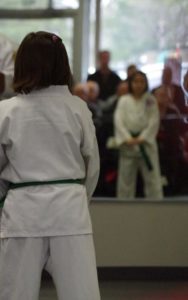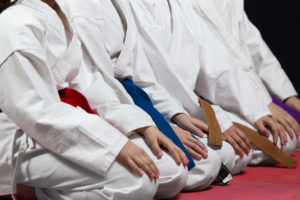Two years ago my, then ten-year-old, daughter and I started a journey together. We joined a local dojo (karate school). At the time my daughter was still looking for ‘her’ activity, and after trying both girl scouts and 4H as well as several intramural sports, I reached back into her early childhood when she had enjoyed participating in karate classes as a three and four year old. I was hoping to find an activity that we could share (much as her brother and father share camping and outings with Boy Scouts) that we would both find challenging and enjoyable—and maybe part of me had secretly always wanted to be a ninja.
A number of friends, family and even acquaintances have expressed surprise that this was the activity that my daughter and I settled on, or more specifically, that I was taking up karate as an adult. We tend to associate karate with classes of kids in white gis, or with high-intensity, high-level competitive martial artists, which we typically think of as male. But this is not a “kid only” or “male only” sport. According to the New York City-based research firm, Simmons Market Research, over 18.1 million Americans participated in karate or some other form of martial art at least once, and roughly 9.4 million were adults. The study also found that gender is pretty evenly split between men (52%) and women (48%). Karate is popular globally, with an estimated 50 to 100 million practitioners worldwide (Japan web and World Karate Federation, respectively), and was one of five new sports added to the 2020 Olympics in Tokyo.
 Martial Arts Improves Physical and Cognitive Performance in Youth
Martial Arts Improves Physical and Cognitive Performance in Youth
It is easy to find the reasons why people enroll their children in martial arts training. Participation in karate has been shown to improve physical performance in children and young adults as measured by such things as better coordination, reaction speed time, explosive leg strength and muscle endurance (1, 2). At the same time, children participating in karate also score better than their peers on executive functions, working memory and visual selective attention (1). Karate has also shown promise in helping with behavior issues by improving self-regulation and executive function (3).
When you look at the literature, though, it is clear that the benefits of martial arts such as karate are not limited to children and teens. Continue reading “More Than Just a Belt—The Benefits of Practicing Martial Arts”

